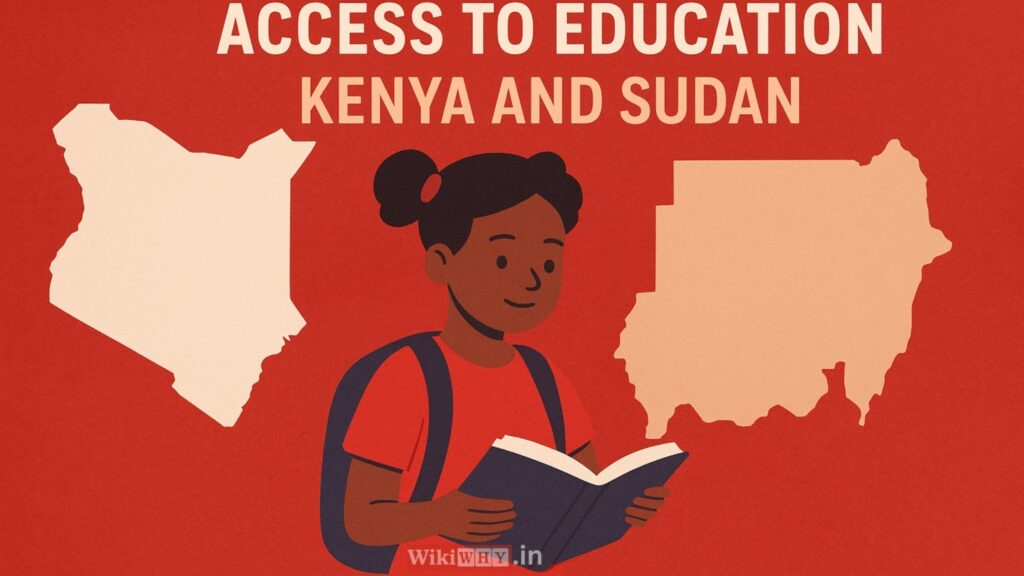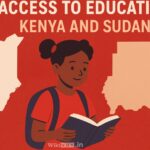Education is more than just learning to read and write. It opens doors, shapes dreams, and builds stronger nations. In Africa, education plays a special role because it helps lift families out of poverty and brings hope for a better future. But not every country has the same access to it.
Almost every country in the world recognizes education as a basic human right. Many even protect it in their national constitutions.
For example,
- The United States promotes free public education through its state laws and the Equal Protection Clause of the 14th Amendment.
- The United Kingdom ensures the right to education under Article 2 of the First Protocol of the Human Rights Act (1998).
- In India, the Right to Education Act (2009) gives every child between 6 and 14 years the right to free and compulsory schooling under Article 21-A of the Constitution. Similarly, Kenya’s Constitution (2010) also declares education a basic right for every citizen.
Still, laws on paper don’t always match reality. Kenya and Sudan show two very different stories. In Kenya, many children walk to school every morning with bright smiles and simple goals to learn, to grow, and to make their parents proud.
In Sudan, however, many children face long walks, conflict, and a shortage of schools and teachers. Some learn under trees or in tents, while others are forced to stay home because of war or poverty.
Both countries believe education can change lives, yet their challenges are not the same. Kenya has made steady progress through better policies, community programs, and government support. Sudan still struggles with the effects of conflict, weak infrastructure, and limited resources.
By comparing the two, we can understand how history, politics, culture, and peace shape the classroom experience. This article analyzes why access to education in Kenya and Sudan differs — and what both nations can learn from each other to make education truly reachable for every child.
Historical Background and Evolution of Education Systems
The story of education in Kenya and Sudan began long before modern schools existed. In both countries, learning first happened through traditions, family guidance, and community teaching. Elders passed down knowledge about farming, leadership, and social values through stories and practice. Education was not written in books, but it prepared children to live responsibly in their communities.
Education in Kenya: From Mission Schools to Modern Classrooms
In Kenya, modern education took root during the British colonial period in the early 1900s. Missionaries were among the first to build schools, mainly to teach reading, writing, and Christianity. However, these schools were not meant for everyone. Many were built in areas close to missions, leaving rural children with little or no access.
After independence in 1963, Kenya began to rebuild its education system to serve its own people. The new government saw education as the key to development and unity. It introduced the 7-4-2-3 system — seven years of primary, four of secondary, two of advanced secondary, and three of university education. Over time, this system changed to meet new needs.
In 2003, Kenya made a major step forward by launching Free Primary Education (FPE). For the first time, millions of children could go to school without paying fees. Later, Free Day Secondary Education (FDSE) followed in 2008. These reforms increased enrollment across the country.
More recently, Kenya introduced the Competency-Based Curriculum (CBC) to replace the old exam-heavy approach. The CBC focuses on skills, creativity, and problem-solving — helping students apply what they learn in real life. While challenges remain, Kenya’s education system continues to expand and modernize, giving more children a fair chance to learn.
Education in Sudan: Struggles and Shifts Over Time
Sudan’s educational journey has been more difficult. Like Kenya, Sudan’s formal education also began under colonial rule — first by the British and Egyptians in the early 1900s. During that time, only a few schools existed, mostly for boys in cities. Rural areas, especially in southern Sudan, were largely left out.
When Sudan gained independence in 1956, the new government tried to expand education, but political instability and civil wars made it hard to build schools or train teachers. For decades, the country faced division between the north and the south, each region following different systems and languages of instruction.
Conflicts in the 1980s and early 2000s caused many schools to close. Thousands of children were displaced or forced into refugee camps. Teachers left their jobs, and infrastructure was destroyed. Even after South Sudan became independent in 2011, Sudan continued to face internal unrest and economic challenges that slowed progress in education.
Despite these hardships, Sudan has made efforts to rebuild. The government, along with international partners like UNICEF and UNESCO, has launched projects to reopen schools, train teachers, and provide education to children affected by war. In some areas, community-based and mobile schools now serve children who otherwise would have no access at all.
Government Policies and Legal Frameworks
Education is not just about schools—it is also about laws, policies, and government support that make learning accessible for all. In both Kenya and Sudan, government policies have shaped how children go to school, what they learn, and who gets the chance to study. However, the approaches in these two countries are very different.
Kenya: Policies Supporting Access and Quality
Kenya has made education a top priority for national development. The 2010 Constitution of Kenya guarantees every child the right to free and compulsory basic education. This legal framework ensures that children cannot be denied schooling because of gender, disability, or social background.
Over the years, Kenya has implemented several key reforms:
- Free Primary Education (2003): This removed school fees for primary education, allowing millions of children from poor families to attend school.
- Free Day Secondary Education (2008): Extended government support to lower secondary schools, ensuring continued education for children beyond primary level.
- Competency-Based Curriculum (CBC): Introduced to focus on practical skills, creativity, and problem-solving, moving away from memorization-heavy learning.
These policies, combined with investments in teacher training, school infrastructure, and digital learning programs, have helped Kenya increase enrollment and improve education quality across the country.
Sudan: Policies Amid Challenges
Sudan recognizes the importance of education in its constitution and national policies, but implementation has been difficult. Political instability, civil wars, and economic challenges have often disrupted school programs.
Some key initiatives include:
- National Education Policy: Designed to provide access to primary and secondary education, especially in underserved areas.
- Community Schools and NGO Programs: In regions affected by conflict, local communities and international organizations step in to build schools and train teachers.
- Focus on Girls’ Education: Policies exist to reduce gender gaps, but cultural norms and early marriages still create barriers.
Despite these efforts, Sudan struggles to enforce its policies consistently, and many children, particularly in rural and conflict-affected areas, remain out of school.
Key Differences
| Aspect | Kenya | Sudan |
| Legal guarantee | Constitution 2010: free and compulsory education | Constitutional recognition, but limited enforcement |
| Primary education | Free since 2003 | Often interrupted by conflict |
| Secondary education | Free Day Secondary Education (2008) | Limited access in rural/conflict zones |
| Policy focus | Access + quality + skills development | Access + survival + community support |
| Implementation | Nationwide and monitored | Patchy, affected by instability |
Economic and Social Factors Affecting Access to Education
Even with strong laws and policies, education depends on money, social norms, and family support. In Kenya and Sudan, the economic situation and social realities greatly affect whether children can go to school and how well they learn.
Kenya: Growing Economy, Expanding Opportunities
Kenya’s relatively stable economy has helped support education. Government funding for schools, teacher salaries, and learning materials ensures that children can attend school more easily than in many other African countries. Families, too, are more aware of the importance of education, which encourages children to stay in school.
Still, economic challenges remain. Rural areas often have fewer resources than cities. Families sometimes struggle with transport costs, uniforms, or school supplies. Despite these hurdles, community programs, scholarships, and government support help many children overcome financial barriers.
Sudan: Poverty and Conflict Limit Learning
In Sudan, economic difficulties are a major barrier to education. High poverty levels, inflation, and limited government funding make it hard to maintain schools, pay teachers, or provide learning materials. Many families cannot afford school fees, uniforms, or transportation, forcing children to stay home or work instead.
Conflict adds another layer of challenge. Displacement due to war or regional clashes prevents children from attending school consistently. Schools are sometimes destroyed, and teachers may leave their jobs. In these conditions, even basic education becomes a privilege rather than a right.
Social and Cultural Factors
Culture and social norms also play a role in education access:
- Gender Roles: In Kenya, efforts to promote girls’ education have helped narrow the gap, though rural areas still see fewer girls completing school. In Sudan, early marriage and household responsibilities often prevent girls from attending school.
- Community Awareness: Communities that value education are more likely to send children to school regularly. Kenya benefits from strong community engagement, while in Sudan, awareness programs are still limited in some regions.
- Family Responsibilities: In both countries, children in poor families may work to support households, reducing the time and energy they can devote to school.
Comparison of Economic & Social Factors
| Factor | Kenya | Sudan |
| Poverty Impact | Moderate; scholarships & support help | Severe; many children stay home or work |
| Rural-Urban Gap | Exists, but mitigated by government programs | Significant; rural areas often have no schools |
| Conflict Impact | Minimal; occasional local disruptions | High; war and displacement disrupt schooling |
| Gender Equality | Policies support girls; gaps remain in rural areas | Cultural norms limit girls’ education |
| Community Support | Strong; NGOs and local programs active | Limited; international aid often fills gaps |
In short, economic stability and social support make a huge difference. Kenya’s growing economy and proactive communities allow more children to attend school consistently. Sudan, by contrast, faces the dual challenge of poverty and instability, which limits opportunities for millions of children.
Gender and Cultural Influences
Education does not exist in a vacuum. In Kenya and Sudan, gender roles and cultural practices play a major role in determining who can go to school, how long they stay, and what they learn. Understanding these influences helps explain why access to education differs so much between the two countries.
Kenya: Progress with Challenges
Kenya has made significant progress in girls’ education. Policies like free primary and secondary schooling, scholarships, and community awareness campaigns have helped narrow the gender gap. Many girls now attend school regularly and complete secondary education.
However, challenges remain. In rural areas, cultural expectations sometimes prioritize boys’ education over girls’. Early marriages, household responsibilities, or helping with family work can still force girls to leave school before completing their studies. Despite these obstacles, community groups and NGOs actively support girls’ education, encouraging families to keep their daughters in school.
Sudan: Cultural Barriers and Conflicts
In Sudan, cultural and social norms have a stronger influence on education access, especially for girls. Early marriage, domestic duties, and conservative traditions often limit opportunities for female students. Conflict and displacement make the situation worse, as families prioritize survival over schooling.
Boys in Sudan are also affected. In areas affected by war or economic hardship, many boys drop out to work and support their families. Limited schools and long distances further discourage attendance. Even when schools exist, lack of female teachers in some regions can discourage girls from enrolling.
Positive Efforts and Programs
Both countries benefit from initiatives aimed at reducing cultural barriers:
- Kenya: Government campaigns and NGOs focus on girls’ empowerment, mentorship programs, and community awareness.
- Sudan: International organizations like UNICEF and UNESCO support community schools, provide school materials, and encourage girls’ attendance in conflict-affected regions.
Comparison Table: Gender and Cultural Influence
| Factor | Kenya | Sudan |
| Girls’ Attendance | Improving; policies and awareness programs help | Limited; early marriage and cultural norms restrict access |
| Boys’ Attendance | High; some rural dropouts | Moderate; many boys work to support families |
| Cultural Barriers | Exist, especially in rural areas | Strong influence on education; norms limit girls’ schooling |
| NGO & Community Support | Active, widespread | Mostly in conflict-affected areas |
| Overall Impact | Gender gap decreasing | Gender gap remains high |
In summary, culture and gender roles deeply affect education access. Kenya has made steady progress in overcoming these barriers, while Sudan still faces strong cultural challenges compounded by conflict. Policies, community programs, and awareness campaigns play a crucial role in bridging these gaps and ensuring that all children have the chance to learn.
Infrastructure, Teachers, and Learning Environment
Access to schools is only one part of the education story. Classrooms, learning materials, and trained teachers play a crucial role in determining the quality of education. Kenya and Sudan face very different realities when it comes to these elements.
Kenya: Steady Improvement and Modernization
Kenya has invested heavily in school infrastructure. Many communities now have classrooms, libraries, science labs, and digital learning centers. Even in rural areas, efforts are underway to provide basic facilities and clean water.
Teacher training is another focus. The government runs continuous professional development programs to improve teaching quality. Class sizes are still large in some areas, but ongoing recruitment and training help reduce teacher shortages.
The learning environment in Kenya also emphasizes creativity and skills development through the Competency-Based Curriculum (CBC). Students engage in projects, problem-solving, and teamwork, moving beyond rote memorization.
Sudan: Challenges and Struggles
Sudan faces major infrastructure challenges. Many schools, especially in rural or conflict-affected regions, lack buildings, desks, and textbooks. Some children study under trees, in tents, or in damaged classrooms.
Teacher shortages are a persistent problem. Many qualified teachers leave conflict zones, and training opportunities are limited. Overcrowded classrooms and insufficient resources make teaching and learning very difficult.
Despite these challenges, NGOs and community initiatives are helping. Mobile schools, community classrooms, and volunteer teachers provide education to children who would otherwise have none. These efforts ensure that even in difficult circumstances, learning can continue.
Comparison Table: Infrastructure and Learning Environment
| Feature | Kenya | Sudan |
| School Buildings | Expanding; classrooms, labs, libraries | Limited; many damaged or temporary structures |
| Learning Materials | Textbooks, computers, digital resources | Shortages of books and learning materials |
| Teacher Training | Continuous professional development | Limited; teacher shortages common |
| Class Size | Moderate; improving with recruitment | Large; overcrowded classrooms in many areas |
| Learning Approach | Competency-Based Curriculum; project work | Focus often on basics; limited practical learning |
| Community Support | Strong; NGOs and local programs active | Growing; mostly in conflict or remote areas |
Summary
A child’s learning experience depends heavily on infrastructure and teacher quality. Kenya’s investment in schools, training, and modern teaching methods provides children with a better environment to learn and grow. Sudan, however, faces serious gaps due to conflict, limited resources, and teacher shortages. Community and NGO efforts help bridge some of these gaps, but the challenges remain significant.
Conflict, Stability, and Education Access
Education does not exist in isolation. In many countries, political stability and peace are crucial for children to attend school regularly. Kenya and Sudan show how dramatically conflict and stability can influence access to education.
Relative Stability Supports Education-Kenya
Kenya has enjoyed relative peace for most of its post-independence history. While there have been political tensions and isolated conflicts, the overall stability has allowed the government to invest in schools, train teachers, and implement nationwide programs.
Because schools are generally safe and functioning, children can attend regularly. Families are more willing to send their children to school, knowing they will receive a consistent education. This stability has been a key factor in Kenya’s high enrollment rates and improving literacy levels.
Sudan: Conflict Disrupts Learning
Sudan’s history of civil wars, regional conflicts, and political instability has had a devastating effect on education. Many schools have been destroyed, teachers have fled, and children are forced to stay home or become displaced.
- Displacement: Millions of children live in refugee camps or move frequently, making it impossible to attend school consistently.
- Destruction of infrastructure: Classrooms, libraries, and teaching materials are often damaged or unavailable.
- Safety concerns: Parents may keep children home to protect them from violence or recruitment by armed groups.
Even when schools exist, the ongoing instability limits teacher availability, enrollment, and attendance, creating long-term gaps in literacy and skills development.
Comparison Table: Conflict and Education
| Factor | Kenya | Sudan |
| Political Stability | Generally stable; minor conflicts | Frequent conflicts; civil wars |
| School Safety | Mostly safe for children | Many schools unsafe or damaged |
| Attendance | High; consistent | Low; many children displaced or absent |
| Infrastructure Impact | Minor; schools maintained | Severe; destruction common |
| Teacher Availability | Stable | Low; teachers flee conflict areas |
| Education Outcome | Steady literacy and enrollment growth | Low literacy; high dropout rates |
Summary
Stability plays a critical role in education access. Kenya’s relative peace has allowed children to learn consistently and safely, while Sudan’s conflicts continue to disrupt schooling and limit opportunities. This shows that even with policies and resources, education cannot thrive without peace and security.
Comparative Analysis: Kenya vs. Sudan
After examining history, policies, economic factors, gender roles, infrastructure, and conflict, it is clear that access to education in Kenya and Sudan differs significantly. Understanding these differences helps highlight what works, what challenges remain, and what each country can learn from the other.
Key Differences
| Aspect | Kenya | Sudan |
| Historical Development | Missionary schools → National system; steady reforms | Colonial-era schools; disrupted by civil wars and instability |
| Government Policies | Free primary & secondary education; Competency-Based Curriculum | Policies exist but weakly implemented due to instability |
| Economic Factors | Moderate poverty; rural programs & scholarships support attendance | High poverty; many children work or stay home |
| Gender & Cultural Factors | Gender gap decreasing; community and NGO support | Gender gap remains high; cultural norms and early marriage limit girls’ education |
| Infrastructure & Teachers | Expanding classrooms, labs, trained teachers, digital programs | Limited infrastructure; teacher shortages; mobile/community schools |
| Conflict & Stability | Relative peace; schools safe and functional | Frequent conflict; schools destroyed; children displaced |
| Overall Education Outcome | High enrollment and literacy; growing access to quality education | Low enrollment and literacy; limited access and quality |
Lessons from Comparison
- Policies Work Best with Stability: Kenya shows that clear laws combined with political stability create lasting access to education.
- Community Engagement is Key: Both countries benefit when families, local groups, and NGOs actively support schooling.
- Gender Equality Requires Cultural Awareness: Kenya’s success in narrowing the gender gap shows the importance of awareness campaigns and policy enforcement.
- Infrastructure Matters: Classrooms, learning materials, and trained teachers are essential. Even with policies, Sudan’s gaps show how limited resources hinder learning.
- Conflict Severely Limits Access: No policy can fully succeed without peace. Sudan demonstrates the lasting impact of war on education.
Summary
Overall, Kenya has managed to provide wider access, better infrastructure, and more consistent learning opportunities. Sudan faces major challenges from poverty, conflict, and cultural barriers, which limit access and quality. Yet both countries share a commitment to education as a right, and lessons from Kenya’s progress could help Sudan improve in the future.
Role of International Aid and Partnerships
International aid has been a lifeline for both Kenya and Sudan, but the difference lies in how effectively each country uses it. Kenya has maintained strong partnerships with organizations like UNESCO, UNICEF, and the World Bank. These collaborations have helped expand infrastructure, train teachers, and develop modern curricula. Donor confidence in Kenya remains relatively high because of the government’s consistent education policies.
Sudan’s international relationships, however, have been unstable due to sanctions, conflicts, and governance issues. Aid programs often focus on humanitarian relief rather than long-term education development. When conflicts escalate, many international agencies withdraw, leaving education projects incomplete.
This inconsistent support has left Sudan lagging far behind. In contrast, Kenya’s ability to attract and retain international investment has accelerated its educational progress.
Efforts by NGOs and Global Agencies
Even when governments struggle, non-governmental organizations (NGOs) and international agencies play a critical role in supporting education. In Kenya and Sudan, these organizations help provide schools, learning materials, teacher training, and awareness programs, often reaching children who would otherwise be left behind.
Kenya: Enhancing Access and Quality
In Kenya, NGOs work alongside the government to address gaps in education. Examples include:
- BRAC Kenya: Provides early childhood education and literacy programs for children in low-income communities.
- Save the Children: Offers scholarships, teacher training, and school supplies for children in rural areas.
- Local community initiatives: Many Kenyan communities build classrooms, libraries, and after-school programs to supplement formal education.
These efforts complement government programs, ensuring that children not only attend school but also learn effectively.
Sudan: Education Amidst Conflict
Sudan relies heavily on international agencies due to the effects of conflict and limited resources. Key efforts include:
- UNICEF: Builds temporary schools, trains teachers, and provides educational materials in conflict-affected regions.
- UNESCO: Supports literacy programs, vocational training, and curriculum development to help children in disrupted areas.
- Community-based initiatives: Mobile schools and community classrooms help displaced children continue learning despite instability.
These programs are lifelines for education, especially for children living in refugee camps or remote villages.
Comparison Table: NGO and Global Support
| Support Type | Kenya | Sudan |
| School Building | Community and NGO-built classrooms | Temporary schools in conflict zones |
| Teacher Support | Training programs and mentorship | Limited training; mobile teacher initiatives |
| Learning Materials | Textbooks, digital resources, libraries | Basic materials, often supplied by NGOs |
| Focus on Girls | Scholarships, awareness campaigns | Awareness programs, girls’ schools in safer zones |
| Impact | Improved enrollment and learning outcomes | Provides access in regions government cannot reach |
Summary
NGOs and global agencies play a vital role in bridging gaps where government efforts alone are insufficient. In Kenya, they enhance access and quality, while in Sudan, they ensure survival education for children affected by conflict. Their work demonstrates that partnerships between governments, communities, and international organizations are essential to achieving universal education.
Future Outlook and Recommendations
The story of education in Kenya and Sudan shows that access to learning depends on laws, policies, economic stability, culture, and peace. Looking ahead, both countries have opportunities to improve, though their challenges differ.
Kenya: Building on Success
Kenya has made great strides in expanding access, improving infrastructure, and modernizing the curriculum. To continue this progress, recommendations include:
- Address Rural Disparities: Increase resources, teachers, and digital access in remote areas.
- Strengthen Teacher Support: Offer continuous training and incentives to improve teaching quality.
- Promote Gender Equality: Expand awareness campaigns and mentorship programs for girls in rural communities.
- Integrate Technology: Enhance e-learning, online resources, and interactive teaching to prepare students for the modern workforce.
With these measures, Kenya can move closer to universal, high-quality education for all children.
Sudan: Rebuilding Amid Challenges
Sudan faces more complex challenges due to conflict, poverty, and weak infrastructure. Key recommendations include:
- Prioritize Peace and Stability: Education cannot thrive without safety; peacebuilding efforts are essential.
- Invest in Infrastructure: Rebuild schools, provide textbooks, and ensure clean and safe learning environments.
- Train and Retain Teachers: Develop programs to train teachers and encourage them to stay in underserved areas.
- Support Girls’ Education: Implement awareness campaigns and safe spaces for girls to reduce early marriage and cultural barriers.
- Leverage NGO and International Support: Continue partnerships to reach displaced and rural children while gradually strengthening government systems.
If these steps are implemented, Sudan can restore hope and create opportunities for millions of children.
Shared Lessons for Both Countries
- Education Needs Stability: Without peace, even strong policies cannot succeed.
- Community Involvement Matters: Parents, local groups, and NGOs play a critical role in keeping children in school.
- Gender Equality is Essential: Both boys and girls must have equal opportunities to learn.
- Resources and Teachers Make the Difference: Infrastructure, materials, and trained teachers are foundational to quality education.
Conclusion
The journey of education in Kenya and Sudan teaches us that laws, culture, economy, and conflict are deeply connected to learning outcomes. Kenya demonstrates that consistent policies, community support, and stability can expand access and improve quality. Sudan reminds us that conflict and poverty create barriers that require both government action and international assistance.
Ultimately, education is a shared responsibility—of governments, communities, families, and global partners. With commitment, innovation, and peace, every child in Kenya, Sudan, and beyond can have the chance to learn, grow, and shape a better future.
Frequently Asked Questions-FAQs
Why is access to education different in Kenya and Sudan?
Kenya has enjoyed more political stability and stronger education reforms, while Sudan has faced conflict and resource shortages. These differences affect school access, teacher availability, and student enrollment rates.
Does Kenya offer free education?
Yes. Kenya introduced Free Primary Education in 2003 and later expanded it to secondary levels. This policy helped millions of children, especially in rural areas, attend school regularly.
What challenges does Sudan face in education?
Sudan faces problems like school closures due to conflict, teacher shortages, and weak infrastructure. Many children in rural and displaced areas study in temporary shelters or drop out early.
How are girls affected in both countries?
Girls in both Kenya and Sudan struggle with early marriage, poverty, and gender stereotypes. Kenya has made more progress through awareness and scholarships, while Sudan still faces barriers, especially in conflict zones.
What can Sudan learn from Kenya’s education system?
Sudan can learn from Kenya’s free education policies, community engagement, and teacher training programs. These strategies can help Sudan rebuild its system and improve access for all children.
How do global laws protect the right to education?
The Universal Declaration of Human Rights and national constitutions—like India’s Article 21-A, the UK’s Human Rights Act, and Kenya’s Constitution—recognize education as a fundamental right for every child.













